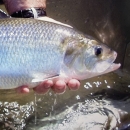States
Connecticut, Delaware, District of Columbia, Maine, Maryland, Massachusetts, New Hampshire, New Jersey, New York, Pennsylvania, Rhode Island, Vermont, Virginia, West VirginiaWe coordinate the horseshoe crab tagging program in cooperation with states, universities, and non-governmental organizations along the Atlantic Coast and Gulf of America. Partners tag horseshoe crabs and send the information to us. Beachcombers, researchers, and commercial fishermen report found tags via our website. Tag information is used to help inform management of horseshoe crabs.
You can help by reporting any horseshoe crabs caught or found with our tag by clicking Horseshoe Crab Tag Form to report online. A certificate of participation containing tagging information is awarded to those who report our horseshoe crab tags.
Background
Until the 1990's, the harvest of horseshoe crabs was regulated by individual states. In 1998, an Interstate Fisheries Management Plan was adopted by the Atlantic States Marine Fisheries Commission. A decline in the horseshoe crab population could severely impact migrating shorebird populations that depend on the eggs for survival.
Horseshoe crabs are harvested commercially as bait to catch whelk (conch), American eels and sometimes catfish. Pharmaceutical companies also harvest horseshoe crabs to extract their blue, copper-based blood which contains a chemical substance, hemocyanin, which clots when exposed to bacteria. The blood is used to test drugs and medical equipment for the presence of harmful bacteria.
The tagging program provides data on distribution, movement, longevity, and mortality of horseshoe crabs. Data are used to inform management decisions about harvest rates. Coast-wide management of horseshoe crabs is essential to maintain healthy populations to benefit shorebirds, the biomedical industry and the commercial fishing industry.



